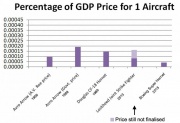The Empire Strikes Out - Canada's Defence & The Commonwealth Space Program - Part 9 by Robert Godwin
From The Space Library
Contents |
Radarsat
One of the options being considered for the bus for Canada's proposed radar satellite was the British heavy geostationary platform L-Sat. SPAR Aerospace in Toronto, where Phil Lapp had been a director, had an agreement with British Aerospace to solicit orders for L-Sat in Canada.
Radarsat had originally been called Sursat (Surveillance Satellite) but the name had been changed out of concerns that it might upset the United States.[1] The primary goal of the proposed satellite was to eliminate the need for thousands of costly aircraft flights required to monitor traffic through Canadian Arctic waters. Clearly both the intent and the execution were primarily motivated by military concerns. But both Lapp and Geoffrey Pardoe's companies could see benefits to sharing the costs and rewards with Britain since the satellite's orbit would cover vast swathes of territory also of interest to British oil and gas companies.
After considerable effort and some salesmanship it looked like Britain would shoulder several hundred million dollars of the cost but would also reap the benefits to the tune of a $197M contract and at least a thousand jobs. Data processing, sales and other tracking responsibilities would also provide rewards. Other contestants in the field to supply the bus were Rockwell, RCA, Lockheed, General Electronics and Matra.
In April 1988 Britain's Thatcher government officially pulled out from Radarsat while in the midst of a spat with the rest of Europe regarding future space expenditures. Instead Britain would consider funding the proposed International Space Station project.[2]
At least one reporter snidely remarked, "No atlas, not even [Margaret Thatcher]'s rubber-boundaried volume, will ever place Canada in Europe."[3]
The collapse of another potentially fruitful British/Canadian alliance had been snapped away, once again, mostly for financial reasons. This proved the concerns that stretched all the way back to MacMillan's day - that Britain simply couldn't afford to "go it alone."
Consequences
No one will ever know if, with Canada as a partner, Blue Streak could have become a competitive alternative to the multitude of missiles available elsewhere. The incredibly reliable Gamma engines built for Black Arrow were much easier to handle than the cryogenic systems being used in the United States and the Soviet Union and were orders of magnitude cheaper to build and fly, with only a modest penalty in performance. They may not have been practical for weapons but they were perfectly practical for a space program. But the natural alliance begun during the war between the RPE in England and CARDE in Canada would never truly live up to its potential.
In December 1962 Lionel Dickinson, the genius British chemist who had come from RPE and created Cardeplex in Valcartier became another of the many scientists lured south. He moved to California and took a position at the Stanford Research Institute. He then spent the rest of his career working for the Explosive Ordnance Department of the U.S. Navy in Maryland. Black Brant's original purpose was hastily and quietly shelved. The highly efficient and inexpensive rocket which his fuel had made possible would, at the hands of Albert Fia and Bristol Aerospace Canada, go on to become Canada's largest space investment in the early 1960s rapidly evolving into a superb scientific instrument.[4] Blue Streak briefly had its moment in the sun as the Europa launcher before being relegated to museum piece.
Both Blue Streak and Black Brant had military roots but the inconvenience of politics turned them into space research systems. Of the two, Black Brant proved to be the survivor. But even without Blue Streak Woomera in Australia would go on to become a world-class space research and launching centre, with thousands of rockets launched.
The Bomarcs would remain part of Canada's defence until 1972 despite evidence that the Soviet Union could jam their guidance.[5] Diefenbaker's successor, Lester Pearson, armed them with nuclear warheads.
In September 1965 The Government of Canada arranged the purchase of 135 Northrup F-5 fighters, at about $1M apiece, and gave the contract to Canadair.[6] The aircraft began to arrive in 1968 but by then there was virtually no functional purpose for them in Canada so they were mostly stored in an RCAF hangar.
Canada's Aircraft Industry
Today the remnants of Avro Canada, after merging with De Havilland Canada, are deeply embedded within the DNA of Bombardier Aerospace.
In 1974 the Canadian government purchased De Havilland/Avro for $38.8M. They sold it in 1986 to Boeing for $90M and a $65M forgivable note with $500M in promised Federal loans. Boeing had made the purchase as a maneuver to strengthen their position in a bidding war.
Air Canada had announced plans to purchase new aircraft for their fleet and Boeing were competing with Airbus, the European aircraft consortium. When Airbus won the contract Boeing's main motivation for keeping De Havilland operational was removed. They immediately put the company up for sale, putting it in distress before it was purchased in 1992 by Bombardier and the Ontario Government for $100M.
The deal with Airbus was later encased in controversy when it was suggested that the Prime Minister of Canada, Brian Mulroney, had been financed by Airbus in his struggle to remove Joe Clark as head of the Conservative party. It was implied that a quid pro quo existed to ensure that Air Canada would buy from Airbus. Mulroney had previously served as executive assistant to one of Diefenbaker's ministers in the 1962 election campaign. It was Diefenbaker's speech writer, Patrick MacAdam (the first person hired by Mulroney when he became head of the party) whose testimony later implicated Mulroney. MacAdam testified that Mulroney and the chairman of Airbus had known each other for years, an allegation Mulroney denied. The chairman of Airbus named in the investigation was none other than Franz Josef Strauss, the same German politician who had been accused of taking bribes from Lockheed to purchase the F-104G for the Luftwaffe in the early 1960s.
In 1976 the Canadian government had purchased Canadair for $38M from General Dynamics in an attempt to "rationalize the aerospace industry."[7] The following year the Canadian government awarded a $3.5B contract to Douglas-Northrup to build 138 F-18 fighters. At that time the government still owned both Canadair and De Havilland and the only other major manufacturer in Canada was Douglas, which had taken over the A.V. Roe factory in Malton.
On the 18th August 1986 after accruing massive losses the government sold Canadair to Bombardier for $120M.
In July 1997 Boeing and Douglas merged. In 2005 Boeing closed the Douglas (Avro) Malton Plant laying off the last 300 workers.
Allowing for inflation, Bombardier (2013) outsells Avro (1958) by almost ten to one and employs 37,000 people: but A.V. Roe Canada was a conglomerate of over 40 companies many of which were in the business of processing raw materials. Once the revenues and employment figures for De Havilland and Canadair are added it makes any true comparison impossible. The evidence seems to suggest that the consolidation was not good for Canada but probably inevitable. In June 2015 the press announced that the government of Quebec was considering purchasing an interest in Bombardier which was struggling to compete in the commercial jet market.
Some Statistics
In relative terms the A.V. Roe layoffs of February 1959 dwarf anything that has ever happened in the United States or Canada before or since.
According to 24/7 Wall street, the largest single layoff in US history was IBM, who laid off 60,000 workers in July 1993.[8]
Canada's population grew by 61% between 1959 and 1993, so the equivalent of the Avro layoff in 1993 would be 21,000 employees.
Since the United States' has roughly ten times as many people as Canada, that would be the equivalent of laying off 210,000 workers in the United States, in 1993. Add another 22% to get the 2015 number (257,000). The sheer scale of the lay off is so enormous as to be almost incomprehensible.
This statistic doesn't make allowances for how Canada's Gross Domestic Product is 44 times larger today than it was in 1960.[9] Or for the 650 sub-contractors who laid off almost as many workers as Avro.
An image of 1,300 A.V. Roe Canada employees in February 1959. After the announcement of the layoffs from the cancellation of the Avro Arrow CF-105. Image has been multiplied by 10x to show 13,000 people to scale. The amount that were actually laid off.
The final purchase price guaranteed in writing by Avro for the Arrow was $3.75M per aircraft.[10] The Diefenbaker government figure, after removing the price of the Sparrow missile system, was $7.78M per aircraft.[11] Neither price included the money already spent on development which would be amortized over the life of the system. The Douglas CF-18 Hornet was $39M per aircraft (in 1980), and the last quoted price (in 2015) for the Lockheed F-35 Joint Strike Fighter was $150M per aircraft.
When factoring inflation and the overall growth in the size of Canada's economy (GDP) between 1959 and 2015 the Hornet was 40% more expensive than Avro's Arrow price and 35% cheaper than the Diefenbaker government's estimate. Since the price is still not locked down (at time of writing) due to an inability to predict production numbers, the F-35 is anything from the same as Avro's quoted price for the Arrow to almost the same as the inflated Diefenbaker price. (See chart)
The Washington Post reported in April 2015 that the F-35 couldn't match the 40 year old F-18 in a combat situation, had experienced engine fires, couldn't run on warm fuel, had an issue with visibility for the pilot and the maintenance software didn't work correctly. The Arrow would have been deployed during the Cold War.
Conclusion
Canada's space program evolved almost exactly as Lapp had foreseen back in 1959, as an adjunct providing technical support and services, but primarily to the United States and Europe and not specifically to the Commonwealth.
Perhaps the greatest loss to Canada in 1959 was the imagination of the Avro team and the R&D they pursued, but the subsequent efforts of the 32 recruited by Robert Gilruth contributed to the greatest technological achievement of the 20th century. The benefits they brought to NASA continue to pay dividends in Canada's space program to this day.
Spawned by British industry Canada's aerospace future was now inextricably entwined with that of the United States, in large part because of the Arrow/Bomarc debacle. The Royal Canadian Air Force never regained its position as one of the preeminent air forces in the world. These issues continue to fester and have become entrenched in the Canadian zeitgeist as evidenced by the number of stories which continue to appear in the newspapers. The history of these events contain hard-earned lessons for future politicians faced with the difficult prospect of weighing budgets against jobs, progress and defence.
In geopolitical terms Britain's role was never the same after the Blue Streak/Skybolt decision. It had acquired a world-class deterrent at the price of losing a space program. De Havilland and Rolls-Royce had both proven that they could build world-class liquid fuel rocket engines and then ultimately they just stopped. The revolutionary HTP engines built for Black Knight were mostly lost to posterity. Britain remains the only country to create its own satellite launch capability and then retire from the field. Canada most recently purchased launch services from India, a country that has three times Canada's space budget, with a GDP only 2% larger.
But without Canada, and certainly without Britain, there could be no Commonwealth space program. However, today British and Canadian engineers produce some of the world's best satellite technology, all launched on rockets built elsewhere. With the British space program completely dissolved away in 1960, the only logical path for a Canadian space program would ultimately go through Washington.
THE END
Go to Chapter
Footnotes
- ^ Radarsat Study 1982 GTS Ltd
- ^ Montreal Gazette May 10 1988
- ^ Financial Post Apr 22 1988
- ^ The Chapman Report - 1967
- ^ Memo from James Floyd to Avro President JL Plant Nov 7 1958
- ^ Globe and Mail July 16 1965
- ^ Globe and Mail Jan 6 1976
- ^ 24/7 Wall St
- ^ World Bank
- ^ Canadian Aviation and the Avro Arrow - Fred Smye (Randy Smye 1989)
- ^ John Diefenbaker - Speech to Parliament - February 20 1958



